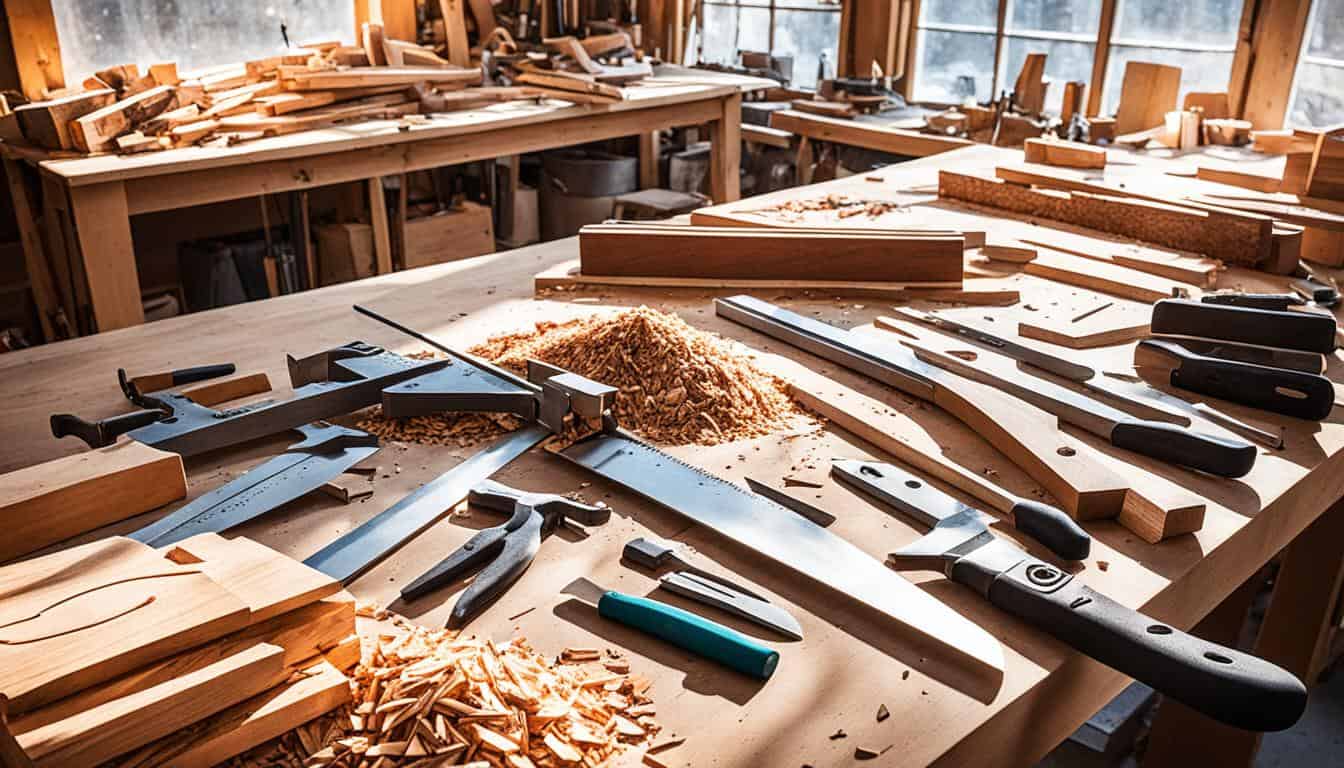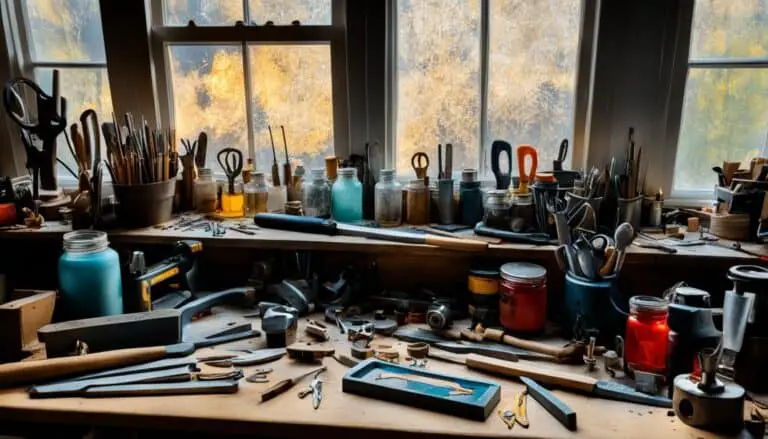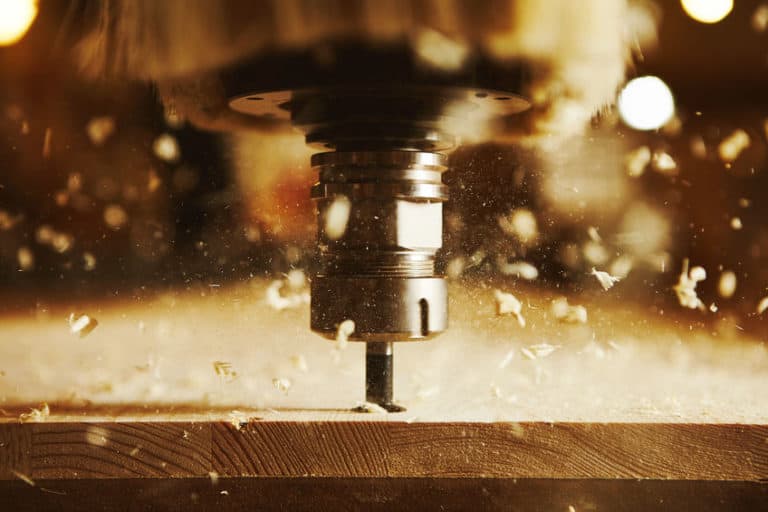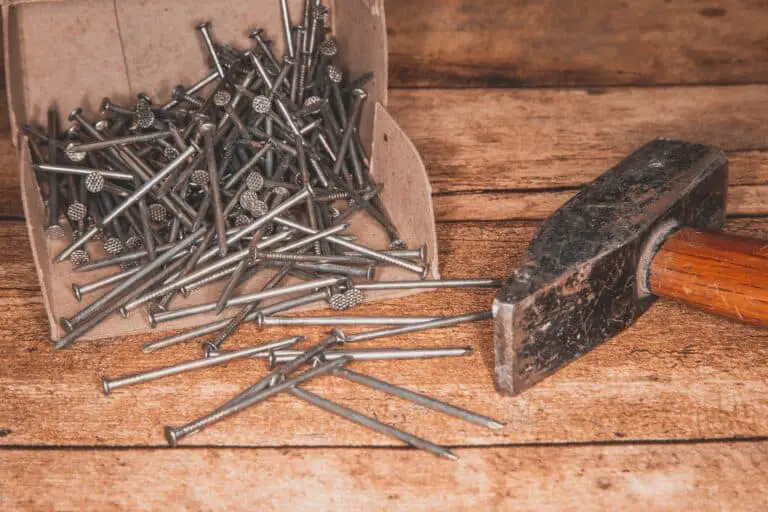Woodworking is a craft that requires skill, precision, and creativity. Whether you’re a beginner or an experienced woodworker, these essential woodworking tips will help you elevate your projects and achieve success. From choosing the right wood to mastering fundamental techniques, this guide will provide valuable insights to enhance your woodworking skills.
Are you ready to take your woodworking projects to the next level? Do you want to unlock the secrets to creating stunning pieces with your own hands? Get ready to discover the essential woodworking tips that will transform your craft and bring your vision to life.
- Choose the right wood for your project based on durability, grain, and workability.
- Invest in essential tools such as saws, hammers, chisels, measuring tape, and squares.
- Create a well-organized and safe workspace with good ventilation and adequate lighting.
- Master fundamental techniques like accurate measuring, clean cutting, and smooth finishing.
- Learn different joinery techniques to create strong and durable joints in your woodworking projects.
Understanding Woodworking Basics
When it comes to woodworking, understanding the basics is the foundation of success. Whether you’re a beginner or an experienced woodworker, knowing how to choose the right wood and having the essential tools is key. In this section, we will explore the importance of woodworking basics, including selecting the perfect wood for your project and having the necessary tools in your toolkit.
Choosing the Right Wood
One of the most critical aspects of woodworking is choosing the right wood for your project. Each type of wood has unique characteristics that can greatly impact the final result. When selecting wood, consider factors such as durability, grain pattern, and workability. Some popular wood choices include:
- Oak
- Maple
- Cherry
- Walnut
- Pine
Each wood type has its own advantages and disadvantages, so it’s important to research and understand the characteristics of the wood before making your selection. Ultimately, the wood you choose should align with your project’s requirements and desired aesthetics.
Essential Tools for Woodworking
To bring your woodworking projects to life, it’s essential to have the right tools at your disposal. While the specific tools you need may vary depending on the project, some tools are considered essential for every woodworker. These tools include:
- Saw
- Hammer
- Chisels
- Measuring tape
- Square
These tools will help you measure, cut, shape, and assemble your projects with precision and accuracy. Investing in quality tools is crucial for achieving professional results, as they ensure durability, reliability, and ease of use.
With a deeper understanding of woodworking basics, including choosing the right wood and having the essential tools, you’re well-equipped to embark on your woodworking journey. In the next sections, we will explore further aspects of woodworking, including workspace setup, fundamental techniques, joinery, and more.
Workspace Setup and Safety
Creating a well-organized and safe workspace is crucial for productive and safe woodworking. By optimizing your workspace setup, you can maximize efficiency and minimize the risk of accidents. Here are some essential tips to consider:
1. Ventilation
Proper ventilation is crucial in a woodworking workshop to prevent the buildup of harmful fumes and dust. Ensure your workspace has adequate airflow by opening windows or using fans. Consider installing an exhaust system or air filtration unit to maintain a clean and healthy environment.
2. Lighting
Good lighting is essential for precision and accuracy in woodworking. Ensure your workspace is well-lit to clearly see your workpiece and avoid mistakes or injuries. Natural light is ideal, so position your workspace near windows whenever possible. Supplement with task lighting such as overhead lights or adjustable workbench lamps.
3. Clean Environment
A cluttered workspace can lead to accidents and hinder productivity. Keep your workspace clean and organized by decluttering regularly. Use storage containers, shelving, and pegboards to keep tools and materials neatly arranged. Clear away sawdust and wood chips to maintain a safe and tidy work area.
4. Personal Protective Equipment
Always prioritize safety by wearing appropriate personal protective equipment (PPE) while woodworking. Essential PPE includes safety glasses to protect your eyes from flying debris, earplugs or earmuffs to prevent hearing damage, and a dust mask or respirator to protect against airborne particles. Wear fitted clothing and sturdy footwear to reduce the risk of accidents.
5. Safe Tool Handling
Proper tool handling is crucial for woodworking safety. Ensure you have a clear understanding of how to use each tool correctly, including hand tools and power tools. Follow manufacturer instructions, use tools for their intended purposes, and keep them in good working condition. Always maintain a firm grip and avoid distractions while operating tools.
6. Workshop Safety Guidelines
Familiarize yourself with general workshop safety guidelines to minimize the risk of accidents. This includes knowing the locations of fire extinguishers and first aid kits, keeping emergency contact information readily available, and understanding the proper procedures for handling and disposing of hazardous materials. Be aware of your surroundings and practice caution at all times.
“A well-organized workspace and adherence to safety guidelines are essential for a successful woodworking experience.”
7. Workspace Setup Checklist
Use the following checklist to ensure your woodworking workspace is optimized for productivity and safety:
| Workspace Setup Checklist |
|---|
| 1. Ensure good ventilation |
| 2. Optimize lighting for visibility |
| 3. Keep the environment clean and uncluttered |
| 4. Wear appropriate personal protective equipment (PPE) |
| 5. Handle tools correctly and safely |
| 6. Follow general workshop safety guidelines |
By following these workspace setup tips and prioritizing safety, you can create an environment that promotes both productivity and peace of mind during your woodworking projects.
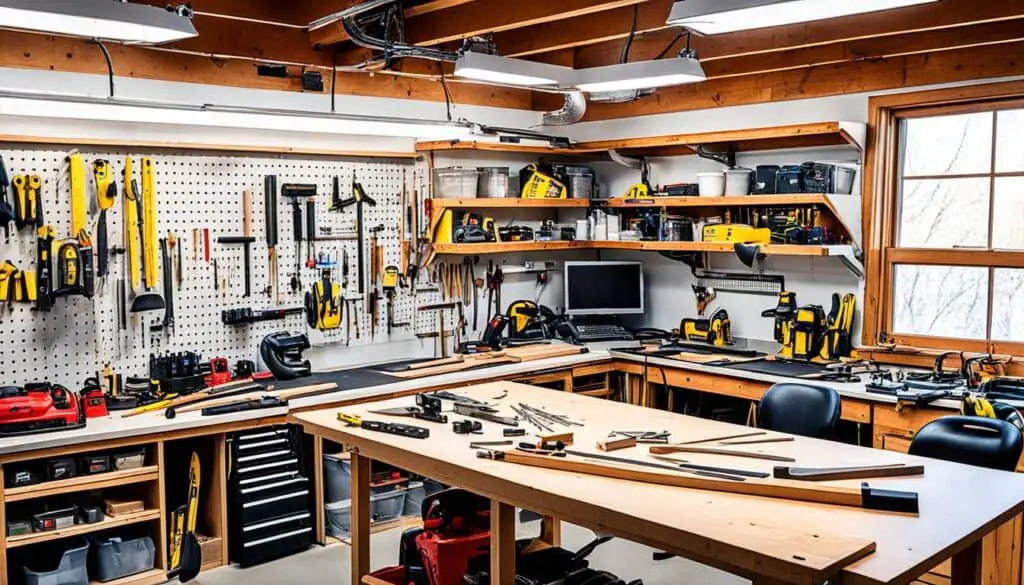
Fundamental Techniques in Woodworking
Mastering fundamental woodworking techniques is essential for producing high-quality projects. In this section, we will explore three key techniques that every woodworker should be familiar with: measuring and marking, cutting and sawing, and sanding and finishing. These techniques form the foundation of woodworking craftsmanship and can significantly enhance the outcome of your projects.
Measuring and Marking
Accurate measurements and precise markings are crucial for achieving the desired results in woodworking. Whether you are marking dimensions, angles, or joints, taking the time to measure and mark properly will save you from costly errors and ensure a seamless assembly process.
“Measure twice, cut once.”
Start by using a high-quality tape measure or a combination square to measure your dimensions. Remember to account for any necessary allowances or overlaps. Once you have determined your measurements, use a pencil or a marking knife to make clear and precise marks on the wood. For more intricate measurements, consider using a marking gauge or a sliding bevel to create accurate angles and reference lines.
Cutting and Sawing
Clean and accurate cuts are essential for a professional finish and a precise fit. Whether you are making straight cuts or intricate curves, using the appropriate saw and employing proper cutting techniques will ensure optimal results.
For straight cuts, a table saw, circular saw, or a handsaw with a straight edge guide can be used. Make sure the wood is securely clamped or supported to prevent any movement. When making curved cuts, a bandsaw, coping saw, or a jigsaw can be employed. Take care to follow the line accurately and maintain a steady pace to achieve smooth curves.
Sanding and Finishing
Creating a smooth, refined surface is the final touch that elevates your woodworking projects. Sanding not only removes any imperfections or rough edges but also prepares the wood for the application of finishes or paints.
Start with a coarse-grit sandpaper and gradually move to finer grits to achieve a smooth surface. Sand the wood with the grain to avoid scratches. Use sanding blocks or orbital sanders for large surfaces and hand sanding for more delicate areas or intricate details. Once the sanding is complete, wipe away any dust using a clean, dry cloth or a tack cloth before applying your chosen finish.
Sanding and finishing not only enhance the aesthetic appeal of your projects but also protect the wood from moisture, wear, and other external factors. Choose a suitable finish, such as varnish, stain, or paint, based on your desired outcome and the type of wood you are working with.
By mastering these fundamental techniques of measuring and marking, cutting and sawing, and sanding and finishing, you will have the foundation needed to create exquisite woodworking pieces.
Joinery Techniques for Strong Joints
Creating strong and durable woodworking projects relies on mastering various joinery techniques. Properly connecting wood pieces is essential for ensuring the longevity and structural integrity of your creations. In this section, we will explore different types of joints and provide step-by-step guides and tips for creating strong and tight joints.
Different Types of Joints
There are several types of joints commonly used in woodworking. Each joint has its own unique characteristics and is suitable for specific applications. Here are three popular types of joints:
- Dovetail Joint: A dovetail joint is renowned for its strength and resistance to pulling forces. It features interlocking wedge-shaped tails and pins, creating a tight and secure connection.
- Mortise and Tenon Joint: The mortise and tenon joint is a versatile joint that provides excellent strength and stability. It involves inserting a tenon (a protruding piece) into a corresponding mortise (a cavity).
- Box Joint: Also known as a finger joint, the box joint is commonly used for joining box-like structures. It consists of interlocking fingers cut into the ends of the boards, creating a strong and visually appealing joint.
Creating Strong and Tight Joints
To ensure your joints are strong and secure, here are some tips:
- Use Clamps: Clamping your joint during assembly helps maintain alignment and ensures a tight fit. Apply even pressure and use the appropriate type and number of clamps for your project.
- Utilize Jigs: Jigs are invaluable tools that aid in achieving precise and repeatable joints. Whether it’s a dovetail jig, mortise jig, or box joint jig, using these specialized tools enhances accuracy and efficiency.
- Ensure Squareness and Alignment: Accurate measurements, proper marking, and meticulous cutting are essential for achieving tight joints. Take your time to ensure the pieces match perfectly and maintain squareness throughout the process.
Incorporating these techniques and following best practices will help you create sturdy and visually appealing joints that will withstand the test of time.
By mastering joinery techniques, you’ll be able to confidently construct robust woodworking projects. The strength and durability of your joints contribute to the overall quality and longevity of your creations.
Advanced Woodworking Skills
Once you have mastered the basic woodworking techniques, it’s time to take your skills to the next level with advanced woodworking techniques. In this section, we will explore the art of curved woodworking, the beauty of veneering and inlays, and the use of woodworking machines.
Curved Woodworking
Working with curves adds a touch of elegance and creativity to your woodworking projects. One essential tool for curved woodworking is a bandsaw, which allows you to make rough cuts and shape the curves of your project. Whether you’re creating a curved tabletop or a wooden sculpture, the bandsaw is a versatile tool that gives you the freedom to express your artistic vision.
Once the rough cuts are made, refining the curves with hand tools is crucial for achieving smooth and precise results. Rasp and carving tools can be used to shape and refine the curves, ensuring a flawless finish.
Veneering and Inlays
Veneering and inlays are decorative techniques that can elevate your woodworking projects to a whole new level. Veneering involves applying a thin layer of wood, known as veneer, to the surface of your project to create intricate patterns or add visual appeal. This technique allows you to work with different wood species, colors, and grains to achieve stunning and unique designs.
Inlays, on the other hand, involve inserting decorative elements, such as contrasting wood, metal, or stone, into the surface of your project. This technique allows you to create intricate patterns, motifs, or personalized designs that make your woodworking projects truly one-of-a-kind.
Using Woodworking Machines
Woodworking machines can greatly enhance your productivity and precision. Machines such as routers, lathes, and planers are indispensable for certain woodworking tasks.
A router is a versatile tool that can shape edges, create intricate designs, and cut joinery. It allows you to unleash your creativity by adding decorative details or creating precise cuts.
A lathe enables you to turn wooden blanks into beautiful round objects such as bowls, vases, or table legs. With the lathe, you can achieve smooth curves and intricate shapes with ease.
A planer helps you achieve uniform thickness and smoothness in your boards, ensuring that they are ready for joinery and assembly. It saves time and effort by quickly removing rough surfaces and making your woodworking projects more refined.
When working with woodworking machines, it is crucial to prioritize safety. Read the manufacturer’s instructions, wear appropriate safety gear such as goggles and ear protection, and ensure that the workspace is well-ventilated.

| Tool | Function |
|---|---|
| Bandsaw | Cutting curves and rough shaping |
| Rasp and Carving Tools | Refining curved surfaces |
| Router | Creating decorative edges and joinery |
| Lathe | Turning wooden blanks into round shapes |
| Planer | Smoothing and thicknessing boards |
By mastering curved woodworking, veneering and inlays, and utilizing woodworking machines, you can unlock a world of possibilities in your woodworking projects. These advanced techniques allow you to push the boundaries of your creativity and craftsmanship, resulting in truly exceptional pieces. Remember to always prioritize safety and continue to learn and develop your skills as you embark on your woodworking journey.
Safety Tips and Importance of Personal Protection
Safety should always be a top priority in woodworking. Ensuring personal protection and maintaining a safe workshop environment are crucial for a successful and secure woodworking experience. By following these safety tips and implementing proper measures, you can minimize the risk of accidents and injuries, allowing you to fully enjoy your woodworking projects.
Importance of Personal Protective Equipment (PPE)
When working with tools and machinery, wearing personal protective equipment (PPE) is essential. PPE acts as a shield, safeguarding you from potential hazards and preventing injuries. Here are some examples of PPE that you should always use:
- Safety glasses: Protect your eyes from flying debris, wood chips, and dust particles.
- Hearing protection: Guard your ears against loud noises produced by power tools.
- Dust masks: Filter out harmful dust and particles, ensuring clean and healthy breathing.
- Gloves: Provide grip, prevent splinters, and protect your hands from cuts or accidents.
- Appropriate clothing: Wear fitted clothing and avoid loose accessories or jewelry that may get caught in tools.
Investing in high-quality PPE is crucial to ensure maximum protection. Always remember to inspect and replace damaged or worn-out equipment to maintain their effectiveness.
Safe Tool Handling and Operation
Proper tool handling and operation are essential for both your safety and the quality of your woodworking projects. Follow these tips to ensure safe tool usage:
- Read the manuals: Familiarize yourself with the manufacturer’s instructions and safety guidelines for each tool.
- Use tools for their intended purposes: Avoid using tools in ways they were not designed for, as it can be dangerous and lead to accidents.
- Keep tools sharp and well-maintained: Dull tools can cause accidents, so regularly sharpen and maintain your tools.
- Secure your workpiece: Use clamps or other appropriate methods to secure your workpiece, ensuring stability during the woodworking process.
- Take breaks: Fatigue can lead to mistakes and accidents. Take regular breaks to rest and regain focus.
Workshop Safety Guidelines
In addition to personal protection and safe tool handling, maintaining a safe workshop environment is crucial. Here are some workshop safety guidelines to follow:
- Keep your workspace clean and organized: A clutter-free workspace reduces the risk of tripping or accidents caused by misplaced tools or materials.
- Maintain good ventilation: Proper ventilation helps to remove dust, fumes, and other pollutants from the air, improving air quality and promoting a healthier working environment.
- Ensure adequate lighting: Good lighting is essential for accurate measurements and safe operation of tools. Ensure your workspace is well-lit.
- Have essential safety equipment readily available: Keep a fire extinguisher, first-aid kit, and emergency contact information easily accessible in case of emergencies.
| Common Workshop Hazards | Safety Measures |
|---|---|
| Noise from power tools | Use hearing protection |
| Flying debris | Wear safety glasses |
| Inhalation of dust particles | Wear a dust mask |
| Cuts or splinters | Use appropriate gloves |
| Tripping hazards | Keep workspace clean and organized |
By incorporating these safety tips and guidelines into your woodworking practice, you can create a safe and secure environment for yourself and minimize the potential risks associated with woodworking. Remember, prioritizing safety ensures that you can continue enjoying the craftsmanship and satisfaction that woodworking brings.
Tips from Professional Woodworkers
When it comes to woodworking, learning from experienced professionals can provide valuable insights and shortcuts to elevate your craftsmanship. The woodworking community is a treasure trove of knowledge, with passionate experts willing to share their expertise. Here are some tips from professional woodworkers that can help you enhance your skills:
Gather Insights and Learn from the Woodworking Community
Attending workshops, joining woodworking forums, and exploring online resources are excellent ways to tap into the wisdom of professional woodworkers. These platforms provide opportunities to connect with experienced craftsmen who can offer guidance, answer your questions, and share their tried and tested techniques.
“The woodworking community is incredibly supportive and generous with their knowledge. Don’t be afraid to ask questions and seek advice. We all started somewhere, and we understand the value of passing on what we’ve learned.” – Mark Johnson, Professional Woodworker
Subscribe to Woodworking Magazines and YouTube Channels
Woodworking magazines and YouTube channels are valuable resources for garnering inspiration, learning new techniques, and staying updated on the latest trends in the craft. Many professional woodworkers have their own channels where they share tutorials and project guides, providing you with an in-depth understanding of their methods.
“Woodworking magazines and online content have been instrumental in my growth as a woodworker. They expose you to different styles, materials, and innovative techniques that can transform your projects.” – Sarah Thompson, Professional Woodworker
Network with Woodworking Professionals
Building connections with seasoned professionals in the woodworking industry can open up opportunities for mentorship, collaboration, and further learning. Attend woodworking events, exhibitions, and trade shows to connect with professionals who share your passion for the craft. Engaging in thoughtful conversations and showcasing your work can lead to valuable insights and potential partnerships.
Experiment and Embrace the Learning Process
Professional woodworkers often emphasize the value of experimentation and embracing the learning process. Don’t be afraid to push the boundaries of your skills and try new techniques, even if they seem challenging at first. Mistakes and failures are a natural part of growth, and they offer valuable lessons that will ultimately shape you into a better woodworker.
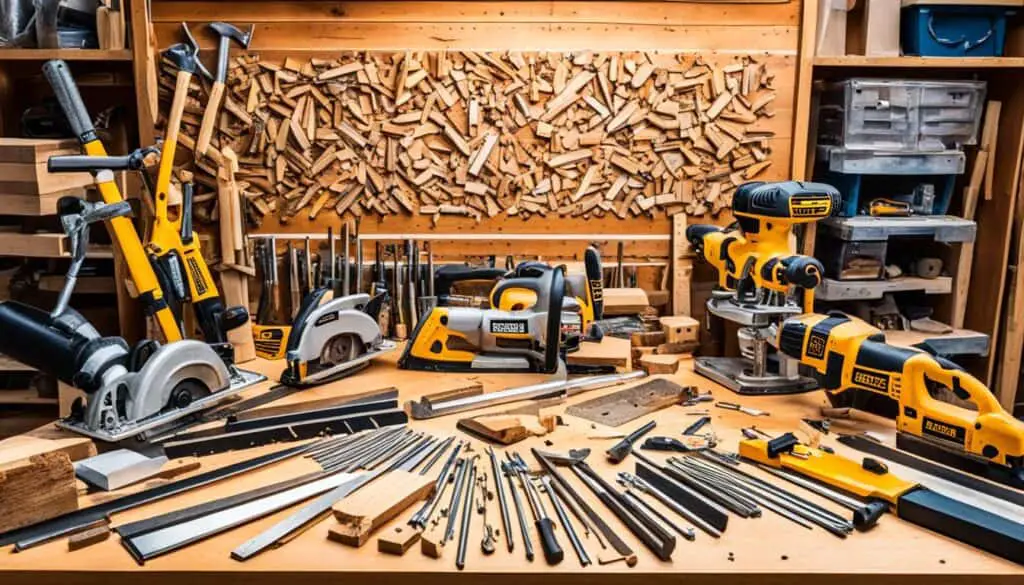
By incorporating tips from professional woodworkers into your woodworking journey, you can gain valuable insights, refine your techniques, and unlock your true potential as a craftsman. The woodworking community is a rich source of inspiration and knowledge, waiting to guide you on your path to woodworking excellence.
Resources for Continuous Learning
Woodworking is a craft that allows for continuous growth and development of skills. To enhance your woodworking journey, there are various resources available that provide valuable knowledge and inspiration. Whether it’s books, online platforms, or woodworking classes, these resources can take your woodworking skills to the next level.
Books
If you prefer to learn through reading, there are many woodworking books that can serve as invaluable resources. One highly recommended book is “The Complete Manual of Woodworking” by Albert Jackson and David Day. This comprehensive guide covers essential woodworking techniques, tools, and projects, making it an excellent reference for both beginners and experienced woodworkers.
Online Platforms
With the advent of technology, there is an abundance of online platforms that cater to woodworking enthusiasts. One such platform is MasterClass, which offers online courses taught by renowned woodworking experts like Sam Maloof and Jimmy DiResta. These courses provide step-by-step instructions, tips, and techniques, allowing you to learn at your own pace and convenience.
Another valuable online resource is YouTube. There are numerous woodworking channels where experienced woodworkers share their knowledge and expertise through tutorials, project walkthroughs, and tool reviews. Some popular channels include Woodworking for Mere Mortals, The Wood Whisperer, and Steve Ramsey’s Woodworking for Mere Mortals.
Woodworking Classes
If you prefer a more structured learning experience, attending woodworking classes can be immensely beneficial. Local community colleges often offer woodworking courses that cater to different skill levels, from beginner to advanced. These classes provide hands-on training, allowing you to learn under the guidance of experienced instructors and collaborate with fellow woodworkers.
Moreover, woodworking classes provide an opportunity to access specialized tools and equipment that may not be available in your personal workshop. This allows you to explore techniques and projects that require specific tools, broadening your woodworking repertoire.
Inspiration and Community
Aside from books, online platforms, and classes, there is value in seeking inspiration and engaging with the woodworking community. Online forums and social media groups dedicated to woodworking provide forums for sharing ideas, seeking advice, and gaining inspiration from fellow woodworkers.
Additionally, attending woodworking shows and exhibitions can expose you to new techniques, trends, and innovations in the woodworking world. These events often feature demonstrations, workshops, and opportunities to connect with industry professionals and fellow enthusiasts.
Ultimately, the key to continuous learning in woodworking is to explore a variety of resources, experiment with different techniques, and engage with the vibrant woodworking community. Embrace the opportunity to expand your knowledge and refine your skills, and watch your woodworking abilities flourish.
| Resource | Description |
|---|---|
| Books | “The Complete Manual of Woodworking” by Albert Jackson and David Day |
| Online Platforms | MasterClass – Online courses taught by woodworking experts |
| YouTube Channels | – Woodworking for Mere Mortals – The Wood Whisperer – Steve Ramsey’s Woodworking for Mere Mortals |
| Woodworking Classes | Local community colleges offer woodworking courses for all skill levels |
Woodworking is a Journey
Woodworking is not just a hobby or a skill; it is a journey of continuous learning and practice. As you embark on your woodworking journey, you’ll discover that each project is an opportunity for growth and creativity. Embracing the challenges that come with woodworking and enjoying the process of creating will make your journey even more fulfilling.
Throughout your woodworking journey, you’ll encounter different projects, techniques, and materials that will expand your knowledge and skills. Continuous learning is a fundamental part of this craft, allowing you to develop new techniques, explore innovative designs, and refine your craftsmanship.

As you dedicate yourself to woodworking, each piece you create becomes a reflection of your dedication and passion. Each project is an opportunity to express your creativity and hone your skills. Whether you are crafting a simple cutting board or a complex piece of furniture, your dedication shines through in the details and the quality of your work.
Woodworking is a journey that requires patience, persistence, and a commitment to continuous improvement. Along the way, you’ll face challenges and setbacks, but these experiences will only make you a better woodworker. Embrace them as opportunities to enhance your skills, learn from your mistakes, and grow as an artisan.
“Woodworking is about more than just creating beautiful objects; it’s about the journey of self-discovery and personal growth that comes with working with your hands.”
– Alex Johnson, Master Woodworker
Remember that dedication is key on this journey. Each time you step into your workshop, you’re investing in your craft and yourself. The more you dedicate yourself to woodworking, the more you will develop your skills, gain confidence, and create remarkable pieces that showcase your evolving craftsmanship.
Embrace the challenges, enjoy the process, and let each project be a testament to your continuous learning. Your woodworking journey is a remarkable adventure filled with endless possibilities and the satisfaction of creating something beautiful with your own hands.
Introduction: The Joy of DIY Woodworking Projects
DIY woodworking projects offer much more than just the opportunity to create practical or decorative items. They provide a gateway to personal expression and empowerment, allowing you to bring your unique visions to life. There is a profound joy and sense of accomplishment that comes from crafting items with your own hands, using woodworking as a medium for self-expression.
When you engage in DIY woodworking, you have the freedom to explore your creativity and unleash your imagination. You have the power to design and create something truly meaningful and reflective of your own personality and style. From the choice of wood to the intricate details and finishes, each step of the process allows you to infuse your personal touch into every project.
Embarking on a DIY woodworking project can be an empowering experience. It enables you to take control of your own creativity and make something tangible and lasting. As you gain confidence in your woodworking skills, you’ll find yourself venturing into more complex and ambitious projects, pushing your own boundaries and discovering new possibilities along the way.
Not only does DIY woodworking provide a channel for personal expression, but it also offers a sense of empowerment. As you learn and master woodworking techniques, you’ll feel a sense of achievement and pride in your abilities. Each completed project becomes a testament to your growth as a woodworker and serves as a constant source of inspiration for future endeavors.
Embrace the joy of DIY woodworking projects and experience the fulfillment that comes from turning raw materials into beautiful creations. Let your imagination soar, and let your hands shape your visions into reality. Start your woodworking journey today and discover the transformative power of personal expression and empowerment.
Beginner Projects: Start Your Woodworking Journey
Are you ready to embark on your woodworking journey? As a beginner, starting with simple projects is the key to building confidence and developing foundational skills. By taking on these beginner woodworking projects, you’ll gain hands-on experience and begin to understand the principles of woodworking craftsmanship.
To get started, here are a few simple projects that are perfect for beginners:
- Wooden Picture Frames: Create personalized wooden picture frames for your favorite photos. Not only will you learn basic woodworking skills like measuring and cutting, but you’ll also have a beautiful piece to display in your home.
- Cutting Boards: Design and craft your own personalized cutting board. This project allows you to practice precision cutting techniques and experiment with different wood types.
- Small Shelves: Build small wooden shelves that can be used to showcase your favorite collectibles or organize your space. This project will introduce you to fundamental construction techniques like measuring, cutting, and assembling.
Completing these beginner projects will provide a sense of accomplishment and serve as a reminder of your newfound passion for woodworking. Each project you finish will boost your confidence and motivate you to take on more challenging endeavors.
Remember that woodworking is a journey, and as a beginner, it’s important to start with manageable projects that allow you to focus on honing your skills. As your confidence and expertise grow, you can gradually tackle more complex woodworking projects.
So, gather your tools, select a project that excites you, and begin your woodworking journey. With each project you undertake, your skills will sharpen, and your confidence will soar. Happy woodworking!
Intermediate Challenges: Elevate Your Crafting Skills
Once you’ve gained some experience in woodworking, it’s time to level up your skills and take on more complex projects. These intermediate woodworking endeavors will not only test your abilities but also expand your craftsmanship. Explore the art of intricate joinery and bring your creations to life with moving parts. It’s time to push the boundaries and discover new possibilities in your woodworking journey.
Coffee Tables with Intricate Joinery
Creating a coffee table with intricate joinery is a perfect way to showcase your intermediate woodworking skills. Combine different joint techniques, such as dovetails, mortise and tenon, or box joints, to craft a visually stunning piece that is both functional and aesthetic. The precise and seamless connection of the joints will elevate your craftsmanship and make a bold statement in your living space.
Wooden Clocks with Moving Parts
Take your woodworking skills to the next level by building wooden clocks with moving parts. These projects require a keen eye for detail and precise execution. From the carefully crafted gears to the intricate mechanisms, each component of the clock will challenge your understanding of joinery and movement. The end result will be a mesmerizing and functional work of art that will impress anyone who lays eyes on it.
Embrace the complexity of these intermediate woodworking projects and witness your skills soar to new heights. Through mastering joinery techniques and tackling intricate designs, you’ll not only enhance your crafting abilities but also gain a true sense of accomplishment in creating stunning, complex pieces.
Tools of the Trade: Equipping Your DIY Woodshop
A well-equipped woodshop is essential for executing woodworking projects with precision and efficiency. To ensure the best results, it’s important to invest in quality woodworking tools and essential equipment. Here, we’ll explore the key tools that every DIY woodworker should have, along with tips for choosing the right ones.
Table Saw
The table saw is a fundamental tool in any woodshop. It allows you to make accurate straight cuts, rip boards, and create various woodworking joints. When choosing a table saw, look for one with a sturdy build, a powerful motor, and precise cutting features.
Router
A router is a versatile tool that enables you to create decorative edges, cut grooves, and make intricate designs in wood. It’s important to select a router with variable speed control, a comfortable grip, and a range of interchangeable bits for different woodworking tasks.
Workbench
A sturdy workbench provides a stable surface for woodworking projects and offers ample storage for tools and materials. Look for a workbench that is large enough to accommodate your projects, has a robust construction, and includes features like integrated clamps and vises for securing your workpieces.
Chisels
Chisels are indispensable for shaping wood, cutting joinery, and removing material. Invest in a set of high-quality chisels with different sizes and types, such as bench chisels and mortise chisels. Sharpness, durability, and a comfortable handle are key factors to consider when choosing chisels.
Hand Planes
Hand planes are essential for smoothing boards, leveling surfaces, and refining woodworking projects. Consider acquiring a selection of hand planes, including a block plane for general use, a smoothing plane for fine finishing, and a jointer plane for flattening large surfaces. Look for planes with sharp blades, adjustable features, and comfortable handles.
Essential Features to Look for
- Durable construction for longevity
- Ergonomic design for comfort during prolonged use
- Powerful motors for efficient performance
- Precision adjustments for accurate cuts and shaping
- Reliable safety features for protection
By equipping your DIY woodshop with quality tools, you’ll be well-prepared to take on woodworking projects with confidence. Remember to prioritize durability, functionality, and safety when selecting your woodworking tools, as they will greatly influence the quality of your work and the enjoyment of your woodworking journey.
Conclusion
Woodworking is a craft that demands skill, dedication, and a thirst for continuous learning. Throughout this article, we have explored essential woodworking tips and the importance of using the right tools to achieve success in your projects. The journey of woodworking is a fulfilling one, where craftsmanship and passion converge to create beautiful and functional pieces.
By understanding the basics of woodworking, setting up a safe workspace, and mastering fundamental techniques, you can elevate your skills as a woodworker. Additionally, learning different joinery techniques and exploring advanced woodworking skills will further expand your capabilities and possibilities in creating intricate and unique woodworking pieces.
Remember, woodworking is not just about the end result. It is about embracing the challenges, learning from experienced woodworkers, and enjoying the process of bringing your vision to life. With each project, you will grow as a woodworker, honing your craftsmanship and achieving woodworking success.
FAQ
What are some essential woodworking tips for crafting success?
Some essential woodworking tips include choosing the right wood for your project, mastering fundamental techniques, learning various joinery techniques, and ensuring safety in the workshop. These tips will help elevate your woodworking skills and enhance the quality of your projects.
How do I choose the right wood for my woodworking project?
When choosing wood for your project, consider factors such as durability, grain pattern, and workability. Different types of wood have different characteristics, so it’s important to select the wood that best suits your project’s requirements.
What are some essential tools that every woodworker should have?
Essential tools for woodworking include a saw, hammer, chisels, measuring tape, and square. These basic tools will help you measure, cut, shape, and assemble your wood correctly.
How can I set up a safe and organized woodworking workspace?
To set up a safe and organized workspace, ensure good ventilation, adequate lighting, and a clean environment. Use personal protective equipment, practice safe tool handling, and follow general workshop safety guidelines.
What are some fundamental techniques I should master in woodworking?
Fundamental woodworking techniques include measuring and marking accurately, making clean and accurate cuts, and achieving a smooth finish through sanding and finishing. Mastering these techniques will help you achieve quality results in your projects.
What are some important joinery techniques in woodworking?
Important joinery techniques in woodworking include dovetail joints, mortise and tenon joints, and box joints. Learning these techniques and using clamps, jigs, and proper alignment will help you create strong and durable woodworking projects.
What advanced woodworking skills can I learn?
Advanced woodworking skills include working with curves, using decorative techniques such as veneering and inlays, and utilizing woodworking machines such as routers, lathes, and planers. Developing these skills will expand your capabilities as a woodworker.
How can I ensure safety in woodworking?
To ensure safety in woodworking, always wear personal protective equipment such as safety glasses, hearing protection, and dust masks. Practice safe tool handling, maintain a clutter-free workspace, and have essential safety equipment on hand.
Where can I get tips and insights from professional woodworkers?
You can gather tips and insights from professional woodworkers by attending workshops, joining woodworking forums, and exploring online resources such as YouTube channels and woodworking magazines.
What resources are available for further developing my woodworking skills?
Resources for further developing your woodworking skills include books such as “The Complete Manual of Woodworking,” online platforms like MasterClass, local community colleges that offer woodworking classes, and online forums and YouTube channels for tips, tutorials, and inspiration.
How can I embrace the challenges and enjoy the journey of woodworking?
Embrace the challenges and enjoy the journey of woodworking by viewing each piece you create as a reflection of your dedication to this timeless craft. Let each project be a testament to your growth and skills as a woodworker.
What is the joy and empowerment of DIY woodworking projects?
DIY woodworking projects allow individuals to bring their visions to life and create something unique. They provide a sense of personal expression and empowerment by allowing you to craft items with your own hands.
What are some beginner woodworking projects to start with?
Beginner woodworking projects include wooden picture frames, cutting boards, and small shelves. Starting with simple projects helps build confidence and develop foundational skills.
What are some intermediate woodworking projects to enhance my skills?
Intermediate woodworking projects include coffee tables with intricate joinery or wooden clocks with moving parts. These projects further enhance your skills and push the boundaries of your capabilities as a woodworker.
What tools do I need to equip my DIY woodshop?
Essential tools for your DIY woodshop include a table saw, router, workbench, chisels, and hand planes. Investing in quality tools will help you execute projects with precision and efficiency.
What is the key to woodworking success?
The key to woodworking success lies in practicing essential woodworking tips, mastering fundamental techniques, ensuring safety in the workshop, and continuously learning and improving your skills. Dedication and craftsmanship are essential for achieving success in woodworking.


